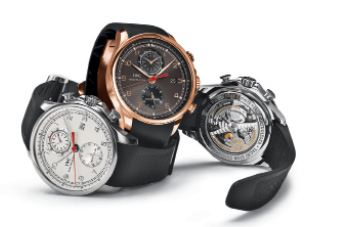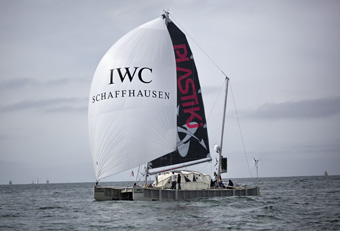- Home
- Media Kit
- Current Issue
- Past Issues
- Ad Specs-Submission
- Ad Print Settings
- Reprints (PDF)
- Photo Specifications (PDF)
- Contact Us

![]()
ONLINE

Craftsmanship
and Heritage
Editors' Note
With the Richemont Group since 2000, Benoit de Clerck served as Managing Director of Richemont’s Watch Division for the Middle East, before assuming his current position in 2004. Prior to joining Richemont, he worked for TAG Heuer and R.J. Reynolds.
Company Brief
Founded in 1868 in Schaffhausen, Switzerland, by a Boston watchmaker, IWC (International Watch Co.) produces handcrafted, luxury timepieces. With nearly 500 employees in Switzerland and around the world, IWC (www.iwc.com) has been owned by Geneva-headquartered Compagnie Financière Richemont SA since 2000.
How has the global economic crisis impacted IWC’s business and what is your outlook for growth in the U.S. market?
Like any other business out there, we were impacted by the global economic crisis. However, I feel that we fared well and are now focusing on the future. We are working hard to get back to where the brand should be and reconfiguring any weak areas that came to light during the crisis. Fortunately, IWC is still one of the most sought after watch brands in the U.S., so we will continue to focus on this market and identify key areas of growth across the country.
Would you provide an overview of the IWC collection and highlight some of the new pieces that you plan to introduce to the market?
The IWC collection is classic, understated, and straightforward. We have six lines within the collection ranging from traditional timepieces to more of an everyday watch. Every year, we decide to revamp one of the lines and, this year, we re-launched one of our most coveted collections – the Portuguese.
The Portuguese line was first created in 1939 when two Portuguese merchants came to IWC Schaffhausen and asked us to produce a watch that was as accurate as a marine chronometer. IWC accepted this challenge and not only created the first oversized wristwatch, but also a watch that was synonymous with navigational tools. The 2010 Portuguese line embodies its heritage but also utilizes IWC’s passion for craftsmanship and highly technical pieces, adding a new depth to the line.
One of the highlights of the line is the new Portuguese Yacht Club, which carries in its genes the precision found in nautical instruments while being the first Portuguese with a distinctively sporty appeal. It is available in steel with a black or silver-plated dial and in red gold with a slate-colored dial. It is water resistant to six bar and houses the IWC-manufactured 89360 calibre movement.
In 2010, the Grande Complication also makes its debut in a Portuguese case. The red gold case is 2.8 millimeters larger and allows the harmonious tones of the minute repeater to unfold even more effectively. Additional complications include a perpetual calendar, a perpetual moon phase display, and chronograph. The watch is limited to 50 pieces per year.

IWC watches from the Portuguese Yacht Club Chronograph collection
The watch industry is very competitive in the luxury segment. How difficult is it to differentiate and how do you define what makes IWC’s watches unique?
IWC has always stood out from the competition for two reasons – we are the only Swiss watch company founded by an American, Florentine Ariosto Jones from Boston, and we are also the only company on the German side of the Rhine which comes across through our clean and precisely engineered designs.
In addition to these key elements, the IWC collection also offers incredible diversity, which many other brands don’t possess. Our lines range from horological specialties such as the new Portuguese Grande Complication to more traditional timepieces like the Aquatimer Chronograph. The collection is segmented by the elements – air, earth, and water – along with a broader spectrum of cultural learning, thus distinguishing our heritage, innovative thinking, and craftsmanship.
IWC is known for its handcraftsmanship. How much of a role is technology playing in the design and production of your watches and has technology had a major impact on your business?
Technology and craftsmanship have always played a very important role in our business and continue to do so in more ways than one. IWC is an expert in traditional watchmaking; however, we have also always taken great strides in the use of avant-garde, high-tech materials. The new Da Vinci Chronograph Ceramic and the Pilot’s Watch Double Chronograph Edition TOP GUN are strong examples of our innovative integration of craftsmanship and technology within the line.
The company’s excellent reputation for craftsmanship and technical innovation was established from the start with the first Jones calibre, named after the founder of IWC. Its many outstanding features included a compensating balance, a Breguet spring, and an elongated index to facilitate precision adjustment. Towards the end of the 19th century, IWC used its 64-calibre ladies pocket watch movement in its first wristwatches. The first real wristwatch movements – the 75 caliber, which had no seconds display, and the 76 calibre with its small seconds – followed in 1915. In 1946, the 89 calibre, the first design to come from IWC’s technical director Albert Pellaton, made a deep impression with its exceptionally precise rate. Pellaton’s masterpiece was IWC’s first automatic movement featuring the winding mechanism that still bears his name.
We are also taking advantage of technology in other ways. The use of online and mobile tools is becoming increasingly important, so this year, we launched our own iPhone application, which has a unique “Try-on” function that enables the user to take a picture of a select watch and adjust the size so that it fits his wrist. We also have just launched the new Portuguese e-book, which is a great interactive tool that takes you through the entire Portuguese collection and hones in on the complications and special features available in the line.
Overall, it is really important for us to stay ahead of the curve and we are trying to do so across many mediums.

IWC sponsored the voyage of the “Plastiki,” a unique boat
constructed entirely of plastic bottles
IWC is known as a leading luxury brand. How do you define the target market for IWC and has the profile of your clientele changed or evolved over the years?
Our target market is relatively easily defined. First, we target affluent men ranging from ages 30 to 65. Our clientele is well-educated and has a profound passion for craftsmanship and heritage. However, what really sets them apart is their desire to be different; to be, “in the know.” IWC is certainly not a “first watch,” but as one becomes more ensconced in the watch world, he comes to see it as a brand that really makes one stand out. It’s like being in on the secret or part of a club, and that characteristic continues to evolve at a rapid pace.•